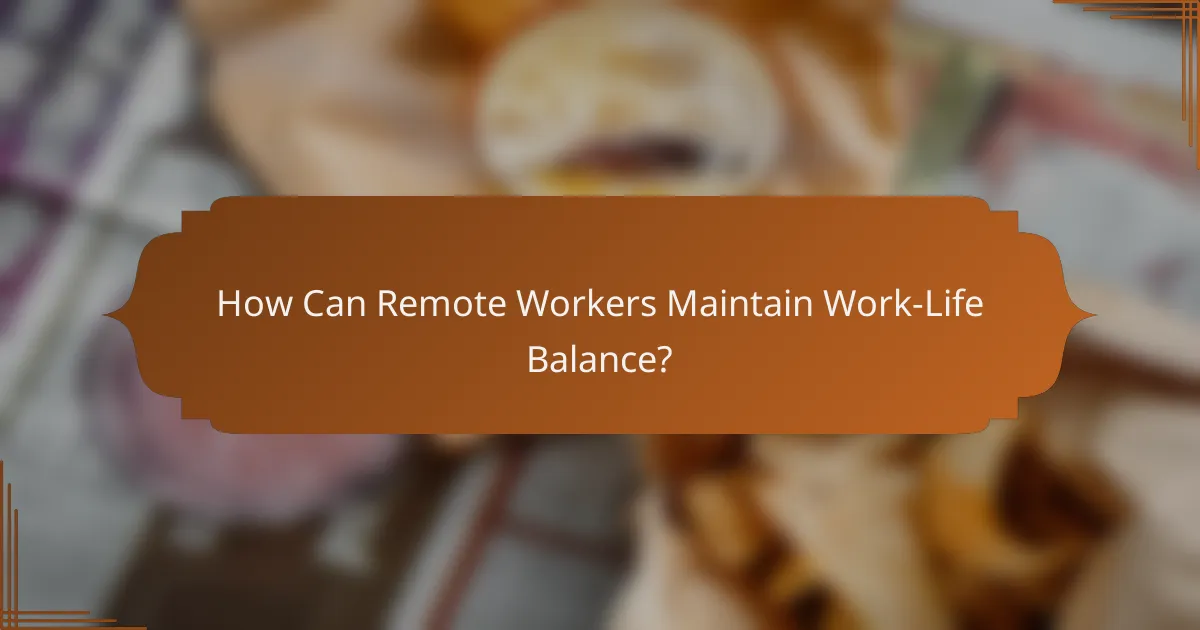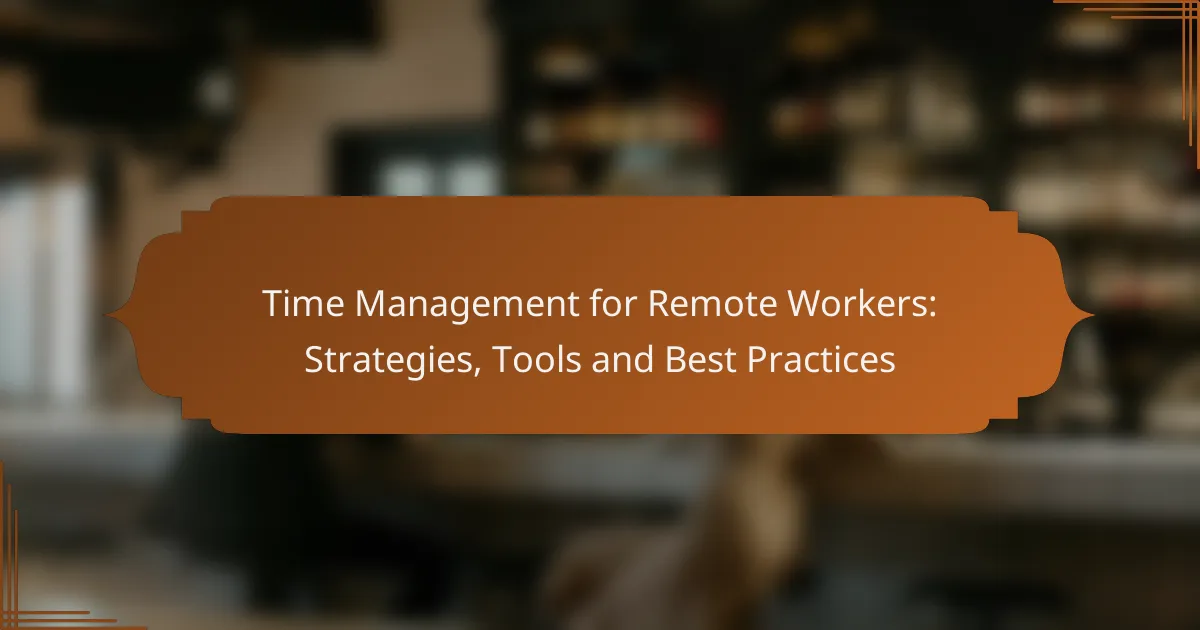Time management is crucial for remote workers seeking to enhance productivity while preserving a healthy work-life balance. By adopting effective strategies and utilizing the right tools, individuals can prioritize tasks, minimize distractions, and create a structured workflow that supports both professional and personal goals.

What Are Effective Time Management Strategies for Remote Workers?
Effective time management strategies for remote workers focus on maximizing productivity while maintaining work-life balance. By implementing structured techniques, remote employees can prioritize tasks, minimize distractions, and achieve their goals efficiently.
Prioritization Techniques
Prioritization techniques help remote workers determine which tasks are most important and urgent. The Eisenhower Matrix is a popular method that categorizes tasks into four quadrants: urgent and important, important but not urgent, urgent but not important, and neither urgent nor important. This visual approach allows workers to focus on high-impact activities.
Another effective technique is the ABCDE method, where tasks are labeled A (most important) to E (least important). This simple ranking system helps clarify what needs immediate attention and what can wait.
Time Blocking Method
The time blocking method involves scheduling specific blocks of time for different tasks or activities throughout the day. By allocating dedicated time slots, remote workers can minimize distractions and enhance focus. For example, a worker might block off 9 AM to 11 AM for deep work and 1 PM to 2 PM for meetings.
To implement time blocking effectively, it’s essential to include breaks and buffer time between tasks. This prevents burnout and allows for flexibility in case tasks take longer than expected.
Pomodoro Technique
The Pomodoro Technique is a time management method that breaks work into intervals, typically 25 minutes long, followed by a 5-minute break. After completing four intervals, a longer break of 15-30 minutes is taken. This approach helps maintain concentration and reduces mental fatigue.
Remote workers can use timers or apps to track their Pomodoro sessions. It’s crucial to eliminate distractions during these intervals to maximize productivity and make the most of each focused work session.
Goal Setting Frameworks
Goal setting frameworks provide structure for remote workers to define and achieve their objectives. The SMART criteria—Specific, Measurable, Achievable, Relevant, Time-bound—help ensure that goals are clear and attainable. For instance, instead of setting a vague goal like “improve sales,” a SMART goal would be “increase sales by 15% in the next quarter.”
Regularly reviewing and adjusting goals is essential to stay aligned with changing priorities and circumstances. This adaptability can enhance motivation and focus over time.
Daily Planning Rituals
Daily planning rituals involve setting aside time each day to outline tasks and priorities. This could be done at the start of the day or the night before. A simple checklist can help remote workers visualize their workload and stay organized.
Incorporating a review of completed tasks at the end of the day can also provide a sense of accomplishment and help identify areas for improvement. Consistency in these rituals fosters a productive routine and enhances overall time management skills.

Which Tools Enhance Time Management for Remote Workers?
Effective time management for remote workers can be significantly improved with the right tools. Utilizing task management, time tracking, communication, and scheduling applications helps streamline workflows and enhance productivity.
Trello for Task Management
Trello is a visual task management tool that allows remote workers to organize projects using boards, lists, and cards. Each card can represent a task, which can be moved through different stages of completion, providing a clear overview of progress.
To maximize Trello’s effectiveness, create boards for different projects and use labels to categorize tasks by priority or team member. Regularly updating the status of tasks can help avoid bottlenecks and ensure accountability.
RescueTime for Time Tracking
RescueTime is a time tracking application that helps remote workers understand how they spend their time on various tasks and applications. It runs in the background and provides detailed reports, allowing users to identify productivity patterns and areas for improvement.
To get the most out of RescueTime, set specific goals for focused work and use its alerts to stay on track. Regularly reviewing your reports can help you adjust your work habits and minimize distractions.
Slack for Communication
Slack is a communication platform designed for teams, offering channels for organized discussions, direct messaging, and file sharing. It helps remote workers stay connected and collaborate effectively, reducing the need for lengthy email threads.
To enhance communication, create dedicated channels for specific projects or topics and utilize integrations with other tools. Be mindful of setting status updates to indicate availability and encourage concise messaging to maintain focus.
Google Calendar for Scheduling
Google Calendar is a scheduling tool that allows remote workers to manage their time effectively by organizing meetings, deadlines, and personal tasks in one place. It offers features like reminders and shared calendars to facilitate collaboration.
To optimize scheduling, color-code events by type (e.g., meetings, deadlines) and set recurring events for regular tasks. Sharing your calendar with team members can help coordinate schedules and prevent conflicts.

How Can Remote Workers Maintain Work-Life Balance?
Remote workers can maintain work-life balance by implementing strategies that clearly separate their professional and personal lives. This includes setting boundaries, creating a designated workspace, taking regular breaks, and incorporating mindfulness practices into their daily routines.
Setting Boundaries
Establishing clear boundaries is crucial for remote workers to avoid work encroaching on personal time. This can involve setting specific work hours and communicating them to colleagues and family members. For example, a worker might choose to be available from 9 AM to 5 PM and refrain from checking emails outside of these hours.
Additionally, using tools like calendar blocking can help visualize and enforce these boundaries. It’s essential to resist the temptation to work late or during weekends, as this can lead to burnout over time.
Designated Workspace
Creating a designated workspace helps to mentally separate work from home life. This space should be comfortable, well-lit, and free from distractions. Ideally, it should be equipped with all necessary tools, such as a reliable computer, ergonomic chair, and good internet connection.
Even if space is limited, having a specific area for work, such as a corner of a room or a dedicated desk, can signal to the brain that it’s time to focus. Avoid working from the couch or bed, as these environments can blur the lines between relaxation and productivity.
Regular Breaks
Taking regular breaks is essential for maintaining focus and productivity throughout the day. A common approach is the Pomodoro Technique, which involves working for 25 minutes followed by a 5-minute break. After four cycles, a longer break of 15-30 minutes can be taken.
During breaks, engage in activities that refresh the mind, such as stretching, walking, or enjoying a snack. This practice not only enhances concentration but also helps prevent fatigue and promotes overall well-being.
Mindfulness Practices
Incorporating mindfulness practices into the daily routine can significantly improve work-life balance for remote workers. Techniques such as meditation, deep breathing exercises, or even short moments of reflection can help reduce stress and enhance focus.
Setting aside just a few minutes each day for mindfulness can create a sense of calm and clarity. Apps like Headspace or Calm offer guided sessions that can fit into a busy schedule, making it easier to integrate these practices into daily life.

What Are Common Challenges in Time Management for Remote Workers?
Remote workers often face unique time management challenges that can hinder productivity. Key issues include distractions at home, lack of structure in daily routines, the tendency to overwork, and feelings of isolation.
Distractions at Home
Home environments can be filled with distractions that disrupt focus and productivity. Common distractions include household chores, family members, pets, and entertainment options like television or social media.
To minimize distractions, create a dedicated workspace and establish clear boundaries with others in your home. Consider using noise-canceling headphones or apps that block distracting websites during work hours.
Lack of Structure
Without a traditional office environment, remote workers may struggle to maintain a structured daily routine. This lack of structure can lead to inconsistent work hours and decreased productivity.
To combat this, set a consistent start and end time for your workday. Use tools like calendars or task management apps to plan your day and prioritize tasks effectively.
Overworking
Remote workers often find it challenging to separate work from personal life, leading to longer hours and burnout. The absence of a physical office can blur the lines between work and leisure time.
Establish clear work-life boundaries by setting specific work hours and taking regular breaks. Use techniques like the Pomodoro Technique, which encourages focused work sessions followed by short breaks, to maintain balance.
Isolation and Loneliness
Working remotely can lead to feelings of isolation and loneliness due to reduced social interactions with colleagues. This lack of connection can negatively impact motivation and mental health.
To mitigate these feelings, schedule regular virtual check-ins with coworkers and participate in online communities related to your field. Engaging in social activities, even virtually, can help foster a sense of belonging and support.

What Criteria Should Be Considered When Choosing Time Management Tools?
When selecting time management tools, consider factors such as usability, integration with existing systems, features that meet your specific needs, and cost-effectiveness. The right tool should enhance productivity without adding complexity.
Usability and User Experience
Usability is crucial when choosing time management tools. A user-friendly interface allows for quick adoption and minimizes the learning curve. Look for tools that offer intuitive navigation and clear functionalities to ensure that all team members can use them effectively.
Integration with Other Tools
Integration capabilities can significantly enhance the effectiveness of time management tools. Choose tools that seamlessly connect with your existing software, such as project management systems, calendars, and communication platforms. This integration helps streamline workflows and reduces the need for manual data entry.
Features and Functionality
Evaluate the features offered by time management tools to ensure they align with your needs. Essential functionalities may include task tracking, time logging, reporting, and reminders. Prioritize tools that provide features tailored to remote work, such as collaborative task assignments and time zone management.
Cost and Budget Considerations
Cost is a significant factor when selecting time management tools. Assess your budget and consider whether a subscription model or a one-time purchase is more suitable for your organization. Many tools offer tiered pricing based on features, so choose one that provides the best value for your specific requirements without overspending.
